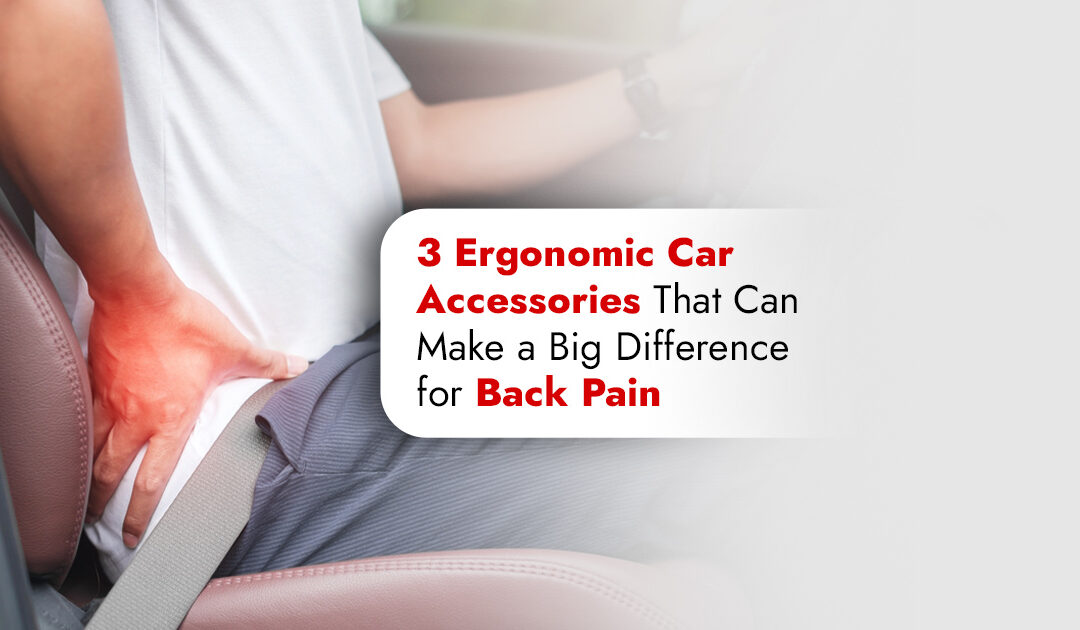Feeling that familiar twinge in your lower back? The stiffness in your shoulders and that ache that seems like an eternal friend as you settle into your car seat? If this sounds like you, you’re not alone in this journey. For many of us, commuting regularly to our workplaces is a pain in itself. Those long hours with no ergonomic support do nothing but elevate your pain and make you desperate for a solution. Before you tell yourself that there is no way out of this discomfort, let us tell you that there is. A few ergonomic changes here and there in your car can not only help you say goodbye to your aches but also make your rides more comfortable and easier.
Think about it—most car seats are made using the general body type as a metric. Hence, they lack the specific comfort that your unique posture needs. This misadjustment can lead to you experiencing poor spinal alignment, added pressure on sensitive regions, and finally, a horrible backache. Investing in ergonomic accessories is almost like giving your car seat a personalized upgrade and tailoring it to your requirements while promoting a healthier driving posture.
If you’re confused about what ergonomic means, it refers to the design and arrangement of things to reduce strain and discomfort on the human body. It concerns establishing a cozy and effective workspace or living space that minimizes the chance of injury and improves productivity.
In application, ergonomic design takes into account aspects such as alignment and positioning of the body, motion and workflow, lighting and climate, design of seating and furniture, and design of tools and equipment. Ergonomics aims to design an environment or system that aligns with the human body, minimizing fatigue, discomfort, and the potential for injury. This can be used in different environments, such as workplaces, residences, and public areas.
What Ergonomic Accessories Should I Get to Relieve My Back Pain?
- Lumbar Support Pillow: If you had to choose one accessory designed for back pain relief in cars, it is the lumbar support pillow. Our lower region of the back has a naturally inward curve, which is essential for maintaining the right spinal alignment. However, plenty of cars manage to flatten or protrude outward in this region, making your spine stay in an unnatural and strained position. This inability to support applies added pressure on your spinal discs, ligaments, and muscles, resulting in discomfort and severe pain over a duration of time.
Choosing the right lumbar support pillow necessitates checking the boxes of shape and size, material, and adjustability. Fix the lumbar pillow in the small region of your back, and let it fill the gap between your lower spine and the seat. This allows you to feel a gentle support, which helps you regain your normal posture.
- A Seat Wedge or Cushion: The angle at which you decide to sit has the potential to affect your spinal cord and pelvis. Several car seats possess a slightly reclined or flat base, causing your pelvis to bend backward. This posterior pelvic bend may further result in pain in the lower back region and excessive strain. When you decide to use a seat wedge or cushion, it helps you experience a soft forward tilt of your pelvis. This might seem like a small change, but it can impact your posture significantly, allowing for a more natural spinal alignment and decreasing pressure on your lower back, hips, and tailbone.
You may choose a wedge, combination or full seat cushion depending on your needs. It is important to choose a cushion that does not elevate you to compromise your head clearance or visibility. Make sure to place it in a way that your hips are slightly higher than your knees when seated.
- Steering Wheel Cover: While this may seem less connected to backache, a good steering wheel cover can heavily impact your overall driving comfort, therefore reducing the strain in your lower back. When you hold the steering wheel for an extended duration, you may feel tension building up in the regions of your hands, wrists, forearms, and shoulders. This may further contribute to discomfort in the lower back or upper back. An ergonomic steering wheel cover is designed keeping in mind the strain required to hold the wheel. Pick a cover made of comfortable, non-slip materials with enough padding and ergonomic contours.
While these ergonomic car accessories may seem helpful, they are better when accompanied by good driving habits. Be sure to maintain a good driving posture and take regular stops to move around and stretch often, specifically on longer routes. Adjust your mirror and seat to make sure that you achieve the best visibility and a comfortable reach to the pedals and steering wheel. If you’re still facing lower backache or difficulties in posture, book an appointment with us today to unlock a healthier version of yourself.

